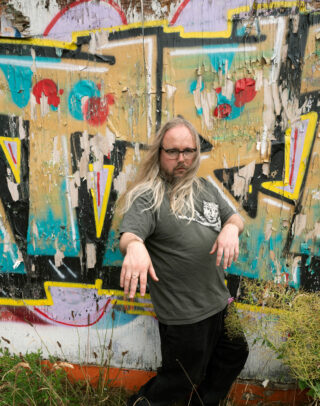“I’ve been steeling myself for people not to like it”: Richard Dawson on making one of the best albums of 2022
A chat with the bard of Newcastle about The Ruby Cord

A chat with the bard of Newcastle about The Ruby Cord
Over the past decade, Newcastle songwriter Richard Dawson has quietly put together an astonishing body of work, his blend of folk, metal, art-rock and experimental music a sound all of his own. In doing so he’s become one of UK independent music’s most beloved artists almost without anyone noticing how much his audience has grown. Not that his work is without its striking qualities or outré moments (he’s made some of this century’s most distinctive, eccentric and viscerally beautiful music of any genre) but his progression from underground cult hero to, well, more famous cult hero has been slow, steady and irrevocable in its influence.
The Ruby Cord is a perfect crystallisation of the creative power that’s got him to this point. His rippling, febrile guitars and moonbeam vocals are as carefully intertwined as ever, unspooling over diffuse song structures that heave and lurch like waking monsters. Yet central to it all is his singular approach to lyric-writing: a freeform procession of characters and images that don’t so much move through tight narratives as populate an ecosystem that’s constantly made and remade by their interplay, a storytelling manner that evokes experimental fiction writers like Thomas Pynchon and M. John Harrison as much as the kind of leftfield folk singers he may be more readily compared to on an aesthetic level. The Ruby Cord contains some of Dawson’s best work yet, and that really is saying something.
Luke Cartledge: The album begins with ‘The Hermit’, a track that’s over 40 minutes long. How did that song begin to formulate, and what made you decide to start your new record with something as long and uncompromising as that?
Richard Dawson: It was the first one I wrote from the album, so it was fronting up the whole time. It wasn’t going to be as long in the original plan, but the more I got into it I realised it needed this space to tell the story. The first third of the song is about where that person is now, then it cuts back to them remembering how they got to that, and for that to work it just needed this space.
My idea about that part of the song [the extended instrumental opening] is that it’s like a forest set to idle, in its most basic mode; so like the improvisation should never build, it’s just a semblance of a gesture, a drawing of a frond waving in the dark, or a little animal scuttling, or a little trickle of water running down a tree trunk. Then it really matters when the character wakes up and comes to consciousness.
LC: Tell us about the trilogy that The Ruby Cord concludes, parts one and two having been Peasant (2017) and 2020 (2019) – was it always intended to be a three-album suite, or has that emerged gradually over time?
RD: Everyone has asked me this. I can’t remember whether I always intended it to be a trilogy or not, but I also don’t know if it is a trilogy or not. I’m not trying to avoid the question – it would be lovely to think I had this intention, but as I’m not even sure if it is a trilogy, I don’t see how I could have intended it.
LC: Your sound is so much lusher and fuller now than in your early work, back when it was mainly just you and a guitar. How has more access to other musicians and creative resources (studio time, instruments, arrangement techniques) impacted your songwriting?
RD: Well, The Magic Bridge [2011] was me getting from one place of not taking things seriously enough to somewhere else where I took responsibility, then when I did The Glass Trunk [2013] I thought about lyrics in a different way, and got to enact that more on Nothing Important [2014], and since then I think I’ve had some approaches and rules through which I’ve found a way to write. So it has changed over the years, but that’s also just natural as you get older – you don’t have the same desperate drive to do stuff, so you have to find ways to keep doing it when you don’t necessarily feel like it. With this last record it’s a bigger production, much more complex, which wouldn’t be possible without the backing of a label, but if it were the case that I wasn’t signed it’d still be the same thing, it’d just have to be presented differently. The spirit would be the same – the songwriting comes first and the arrangements are about how you deliver this as directly as possible. Every instrument has to be a character, or an environment, or a prop, or a chair. But if you didn’t have those things, the text and the melody have to stand on their own; instead of it being a production at the Globe, it could be a school play – it’d still be the same play.
I love going to the studio. It’s always the best time. I like having somewhere to go to work as well, because otherwise I’ve got no structure. My work is like a gas, and for a few weeks it becomes some nice, solid, oaky thing. There you go, that’s the wordsmith in me [laughs].
I’ve no conception of what people think of what I do, and I’ve been steeling myself for people not to like this album. I don’t want to be self-aggrandising but I really believe in it, but I’ve been preparing for it to be absolutely slated. So it’s nice to hear you like it.